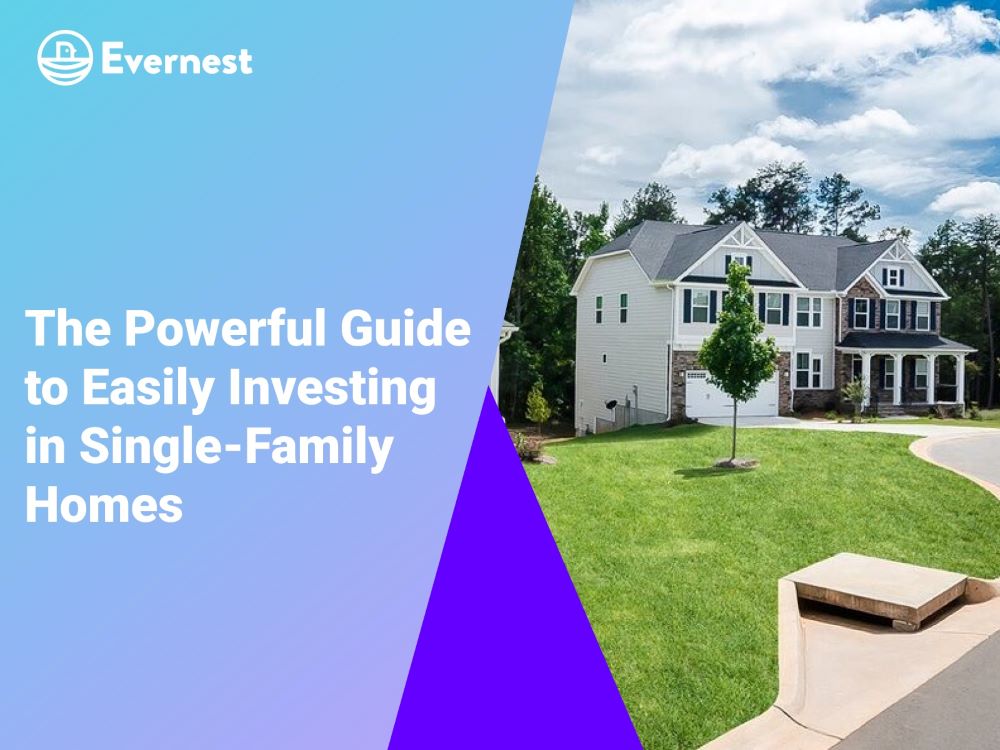The Powerful Guide to Easily Investing in Single-Family Homes
Real estate investing is one of the most bankable strategies to build massive wealth. For beginner investors, investing in single-family homes can be a great first step. After all, single-family homes often offer low risk, great returns, and plenty of flexibility. So, if you’re interested in purchasing your first (or next) SFR, here’s how you can get started today:
What is a Single-Family House?
A single-family house is essentially a home built as a single-unit residence. They are usually built on private parcels of land, meaning the land around the house is for the owner’s private use. It’s detached from other houses around it, meaning it doesn’t share any common walls or roofs. Single-family homes also have private utilities like electricity, water, and heating. Unlike some apartments or multifamily homes, this means they are not shared with other residents. Finally, single-family homes are often traditionally owned or occupied by one person or family.
What is an SFR?
In the real estate investing world, we call single-family homes that an owner or investor chooses to rent out ‘single-family rentals’, or SFRs. This terminology helps clarify the differences between single-family investment properties and multifamily investment properties, like a duplex or apartment complex.
Beginners’ Guide To Investing In Single-Family Houses
Single-family houses are often the best bet for beginners wanting to step into real estate investing. After all, one-third of all US rentals are single-family homes and there is steady, persistent demand for these properties nation-wide. Plus, single-family houses generally increase in value over time. Like other real estate-related assets, single-family homes are also largely unaffected by the stock market. Research conducted by Roofstock shows that the prices of single-family houses are entirely independent of stock prices, meaning that even if stock prices plummet, house prices will not be affected in the same way. In fact, investing in single-family homes almost works like an inflation mitigation system.
Learning About Investing
Before you start your career as a real estate investor, you should learn a few basic aspects of real estate investing. Don’t stress - you don’t need a fancy degree! There are countless blogs, books, and YouTube videos on this topic, which offer all the information you’ll need. Learn all the basic terms, rental property types, local laws, and trends. These factors will all help you make a good investment when it comes time to purchase your first SFR.
Finding the Right Location
When investing in single-family properties, you’ll need to first find the right market. In terms of investing in single-family houses, you’re not only limited to your local real estate market. If the local market isn’t doing too well, or if you’d like to see higher returns in a more affordable market, there’s nothing stopping you from investing elsewhere. Start by determining your investing criteria. For example, do you want a low-risk investment, low vacancy rates, or high returns? Determine your overarching goals, then compile a list of potential markets that best suit your needs. Pro tip: Not sure where to start? We have investor-friendly agents in 25+ markets. We can help clarify your goals, settle on a city, and find the ideal investment property. Just fill out this form and we’ll be in touch.
Honing Your Criteria
Of course, before actually investing in anything, having a clear objective is crucial. Once you’ve determined your overarching goals, it’s time to get more specific. If your main concern is safety and security, you should consider looking into low-risk houses that offer reliable and steady returns in your market of choice. For example, consider investing in a top-tier school district. It may give you a lower yield, but you’ll likely see less risky residents who take better care of the home. On the other hand, if you’re looking for high returns on your investments, then you might want to take a few more risks. Generally, lower-priced homes tend to be riskier, but you’re likely to see higher and longer-term returns.
Managing Your Property
The next step is managing your SFR. Proper management of an investment property can make a world of difference. Depending on the location of your single-family home and its size, self-managing can make a lot of sense. But if your goal is to invest in multiple properties, bringing in professional management is often a better choice. PSST! Need an all-in-one property management provider? Evernest can help.
Creating A Solid Strategy
If you want to succeed in real estate investing, you’ll need a great strategy. You should develop your unique strategy based on budget, location, personal preferences, and goals. Here are a few strategies you can consider when investing in single-family houses:
- Buying and holding property: This strategy mainly entails buying an investment house and holding it with the intent of selling it off in the future. Investors only sell the house after they deem the value appropriate, thus profiting in the process.
- Fix and flip: Fix and flip is a great strategy for making some short-term money. In this process, investors buy distressed houses for cheap and sell them off after making all the necessary improvements.
- Wholesaling: This is the most basic and old-school rental strategy. Essentially, investors buy houses on sale and then sell them off for a profit.
- Traditional rentals: This strategy involves leasing the house for months or years and collecting rental income.
Keep in mind that one strategy isn’t necessarily better than another, they’re just different. The right approach will depend entirely on your unique situation.
Finding Single-Family Houses For Sale
After selecting the area and fine-tuning your approach, the next step is finding single-family homes for sale. Of course, a great way to find the best deals is hiring a real estate agent. An investor-friendly agent will know the market like the back of their hand, have extensive experience with investors like yourself, and work diligently to ensure the buying process goes off without a hitch. You can also consider checking local newspaper listings, looking for “for sale” signs, talking to friends, and utilizing online services.
Analyzing the Investment for Profitability
Once you’ve found some potential investments, you’re not quite done! Before you pull the trigger, you need to determine if the investment will be profitable or not. To do that, you’ll need to perform a property investment analysis. Your home buying team or other resources can help you calculate potential property expenses, occupancy rate, cap rate, rental income, and more. This will help you decide the best rental strategy for the single-family house investment.
Funding Your Investment
This is probably the most important part of your investment. After all, as mortgage rates rise, you’ll need to ensure a secure financial plan for your SFR. To find the best possible deal, shop around with different mortgage lenders. Compare and contrast offerings, terms, and even the financing team. All of these factors will play a role in the funding of your investment.
Investing in Single-Family Homes: Final Thoughts
Getting into real estate investing can be daunting. Fortunately, single-family homes offer a simple and seamless first step, as they often involve fewer risks and higher return on investments. Ready to take the next step?
Get Started Buying Homes With Evernest
Whether you’re purchasing one SFR or one hundred, you don’t have to go it alone. If you’re ready to buy your first (or next) investment property, here are 3 steps to get started today:
- Subscribe to our podcast: The Evernest Real Estate Investor Podcast—for all things real estate investing, being a landlord, growing your portfolio, and more.
- Find a property: Make sure you sign up for our Pocket Listings to get notified of all the deals that come across our desk daily.
- Get an investor-friendly agent: We can help with that—we would love to help you buy your next rental property investment.


